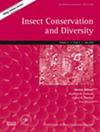Odonata responses to dispersal and niche processes differ across Amazonian endemism regions
IF 3.2
2区 农林科学
Q1 ENTOMOLOGY
引用次数: 0
Abstract

不同亚马逊特有地区的鸟类对扩散和生态位过程的反应各不相同
基于生态位和扩散的过程支配着淡水群落,如水生昆虫,影响着它们在环境中的分布和建立。因此,我们旨在研究亚马逊淡水系统中生态位和扩散过程对蜻蜓多样性的相对影响,以及物种扩散功能特征对其经度和纬度范围的影响。我们使用散布-生态位连续指数(DNCI)来检验(i)距离较远的地区是否普遍存在以散布为基础的过程,以及(ii)两个鸟纲亚目是否存在不同的模式;通过应用广义线性模型,我们检验了(iii)亚目中与散布相关的功能特征是否会影响物种的纬度和经度中点。我们发现,较远地区的成对散布-龛连续值较低,主要是鞘翅目,这证实了我们的第一个假设。此外,鞘翅目物种的 "散布-iche Continuum "绝对值也最低,而鹮科物种则受到生态位和散布过程的共同影响,这与我们的第二个假设一致。只有颧翅类的散布功能特征与纵向中点之间存在显著联系,这证实了我们的第三个假设。我们的研究结果表明,颧翅目昆虫普遍存在与扩散相关的过程,这可以用河流等巨大的地理障碍以及它们狭窄的生理和生态耐受性来解释。此外,与扩散相关的特征对鞘翅目昆虫的纵向中点有显著影响,而河流的存在可以解释这种情况。更好地了解物种的普遍预测因素以及它们的扩散能力如何支配其分布具有保护意义。
本文章由计算机程序翻译,如有差异,请以英文原文为准。
求助全文
约1分钟内获得全文
求助全文
来源期刊
CiteScore
7.70
自引率
8.60%
发文量
58
审稿时长
>12 weeks
期刊介绍:
To publish papers of the highest scientific quality within the general area of insect (and other arthropods) conservation and diversity covering topics ranging from ecological theory to practical management.
Papers are invited on the following topics: Conservation genetics; Extinction debt; Long-term conservation planning and implementation; Global implications of local or national conservation actions; Management responses of species and communities; Captive breeding programs; Comparisons of restored and natural habitats; Biogeography; Global biodiversity; Metapopulation dynamics; Climate change: impacts on distributions and range; Invasive species: impacts and control; Effects of pollution; Genetic threats to diversity by introgression; Effects of fragmentation on diversity and distribution; Impact of agricultural and forestry practices on biodiversity; Enhancing urban environments for diversity and protection; Biodiversity action plans: can we scale up from insects?; Effectiveness and choice of indicator species; Soil biodiversity and interactions with above-ground biodiversity; Ecological interactions at local levels; Ecological and evolutionary factors influencing diversity and local, regional and global scales; Sustainable livelihoods and training on the ground; Integrating science and policy.

 求助内容:
求助内容: 应助结果提醒方式:
应助结果提醒方式:


